Jewellery Making: Techniques, History & Sustainability
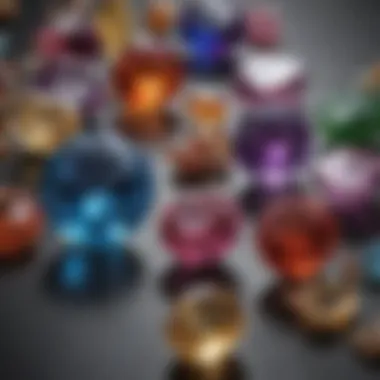
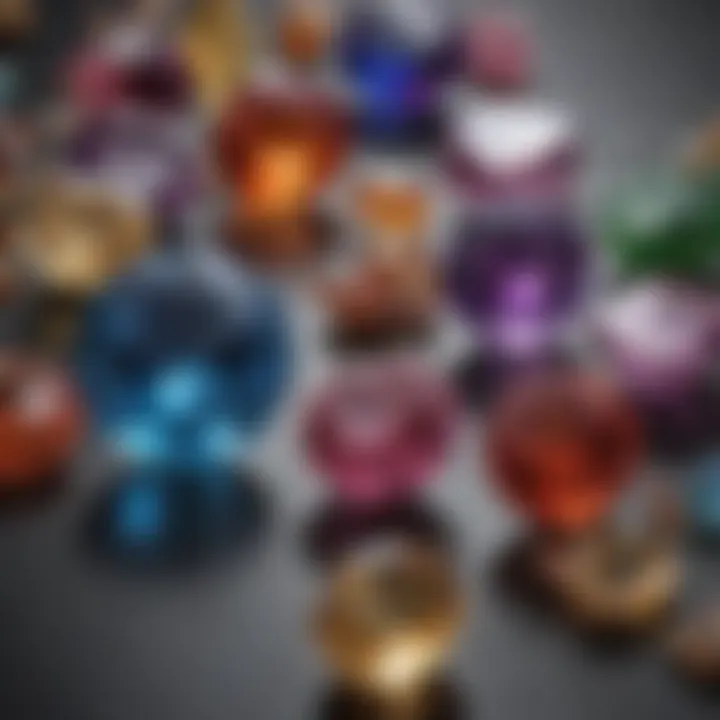
Intro
Jewellery making is an intricate art form that combines creativity with precision. At its heart, the craft is more than mere adornment; it reflects personal stories, cultural significance, and artistic expression. Understanding gemstones is essential for anyone interested in jewellery making, as these elements often serve as the centerpiece of a design. In this exploration, we will dive into the characteristics, properties, and classifications of gemstones, ultimately enhancing the knowledge of jewellery enthusiasts.
Gemstone Overview
Definition and characteristics
Gemstones are naturally occurring minerals, rocks, or organic substances that are cut and polished to be used in jewellery or decorations. They are celebrated for their beauty, durability, and rarity. Each gemstone possesses unique characteristics, which can influence its desirability and value. For instance, a ruby is known for its vibrant red hue, while an emerald is prized for its rich green color.
Characteristics of gemstones can include:
- Color: The visual spectrum of the gemstone.
- Clarity: The presence of internal flaws or inclusions.
- Cut: The way a gemstone is shaped and faceted.
- Carat weight: The measurement of how much a gemstone weighs.
Classification of gemstones
Gemstones are classified in various ways, mainly based on their composition and origin. The two primary categories are:
- Precious gemstones: This group includes diamonds, rubies, sapphires, and emeralds. These stones are often highly sought after due to their beauty and intrinsic value.
- Semi-precious gemstones: This category comprises a wide range, including amethyst, garnet, and turquoise. Although they are generally more abundant, many possess distinct qualities that make them desirable.
"Each gemstone tells a story, echoing the forces of nature that shaped it over millennia."
Properties of Gemstones
Physical properties
Physical properties of gemstones include aspects that can be observed or measured without changing the substance. The most notable physical properties include:
- Hardness: Measured on the Mohs scale, this indicates how resistant a gemstone is to scratching. Diamonds have the highest rating at 10.
- Luster: This refers to how light interacts with the surface of the gemstone. Examples include vitreous, resinous, or pearly.
- Transparency: Gemstones can be categorized as transparent, translucent, or opaque based on how light passes through them.
Chemical properties
The chemical properties provide insight into the composition of gemstones. Each type has a specific chemical formula or structure that determines its classification and characteristics. For example:
- Diamond: Composed entirely of carbon (C).
- Amethyst: A variant of quartz, primarily made of silicon dioxide (SiO2).
- Emerald: A type of beryl, known for its beryllium aluminum silicate, which gives it its vivid color.
By comprehending these properties and classifications, jewellery makers can make informed decisions when selecting gemstones for their crafts. Understanding these elements not only enhances the design aspect but also promotes responsible sourcing and ethical considerations in the craft.
Intro to Jewellery Making
Jewellery making is not merely a craft; it is an art form that embodies culture, tradition, and personal expression. This section serves as a vital foundation for delving deeper into the intricate world of jewellery craftsmanship. Understanding the basic principles of jewellery making can enhance one’s appreciation of the art and provide insight into the various techniques and materials involved.
The significance of jewellery making spans across individual creativity and historical context, with each piece telling a story or symbolizing a sentiment. As we explore this craft, we will uncover the skills required, the tools employed, and the essential role of craftsmanship in the creation of exquisite pieces.
Defining Jewellery Making
Jewellery making refers to the process of crafting decorative items worn for personal adornment. It includes various techniques ranging from designing and molding to finishing and polishing. This craft can utilize a multitude of materials, with metals and gemstones being the most prevalent. The creation of jewellery includes not only aesthetic considerations but also functional elements, as pieces are often designed to be worn in various social contexts.
Through this process, artisans express their creativity and technical skill. While some creations are commercially produced, others are handcrafted, each showcasing the individuality of the artist.
The Importance of Craftsmanship
Craftsmanship is the essence of high-quality jewellery making. It involves precision, attention to detail, and an understanding of materials. Well-crafted jewellery is durable and aesthetically pleasing, making it valuable not just for its material worth but for its artistic merit.
"Craftsmanship goes beyond mere technical ability; it is a commitment to beauty and design found in every piece."
Every piece of jewellery represents countless hours of meticulous work and dedication. Skilled makers must be proficient in various techniques, understand the properties of different materials, and constantly refine their abilities. This level of craftsmanship distinguishes unique pieces from mass-produced items. Achieving mastery in jewellery making is a journey, requiring continual learning and adaptation to new trends, making it a dynamic field to explore.
Historical Context
Understanding the historical context of jewellery making provides insights into how this craft has evolved over centuries. It allows us to appreciate not just the artistry involved, but also the significance of jewellery in various cultures and societies. Furthermore, this exploration aids in recognizing how material choices, techniques, and styles have been influenced by technological advancements and cultural shifts.
A Brief History of Jewellery
Jewellery making dates back to ancient civilizations. The earliest known pieces were made from materials like shells, bones, and stones. These rudimentary items held symbolic importance, often serving as amulets or status symbols.
As societies advanced, so did the craft of jewellery making. In ancient Egypt, for example, gold became a prominent material due to its availability and significance. The use of intricate designs and inlays led to luxurious pieces reserved for the elite. The Greeks and Romans also contributed to this craft, emphasizing natural forms and using gemstones extensively. As trade routes expanded, influences from other cultures began to shape jewellery designs. For instance, the introduction of Eastern techniques and styles enriched the European jewellery landscape during the Middle Ages. Modern jewellery making evolved rapidly with the Industrial Revolution, allowing for mass production and new design styles that catered to a broader audience.
Cultural Significance of Jewellery
Jewellery serves more than an aesthetic purpose; it holds deep-rooted cultural significance across the world. In many cultures, jewellery is associated with rituals and traditions.
- Religious Significance: In numerous religions, jewellery plays a key role in ceremonies. For instance, wedding rings symbolize commitment and are an essential part of matrimonial customs in many societies.
- Social Status: Throughout history, jewellery has been a marker of social status. Precious metals and rare stones often indicated wealth and power. Royal families and nobility adorned themselves with exquisite pieces that demonstrated their rank.
- Personal Expression: Today, jewellery often represents personal identity and individual style. People choose pieces that resonate with their aesthetic preferences or signify important life events.
- Cultural Heritage: Many cultures have traditional jewellery styles that embody their unique heritage. For example, Native American tribes create distinctive pieces that reflect their beliefs and histories.
The relevance of jewellery in both historical and contemporary contexts cannot be overstated. It encapsulates a narrative that links the past with the present, while also enriching our understanding of cultural diversity and craftsmanship.
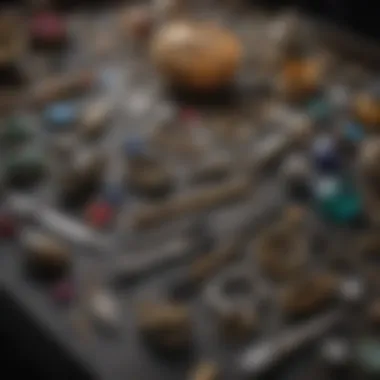
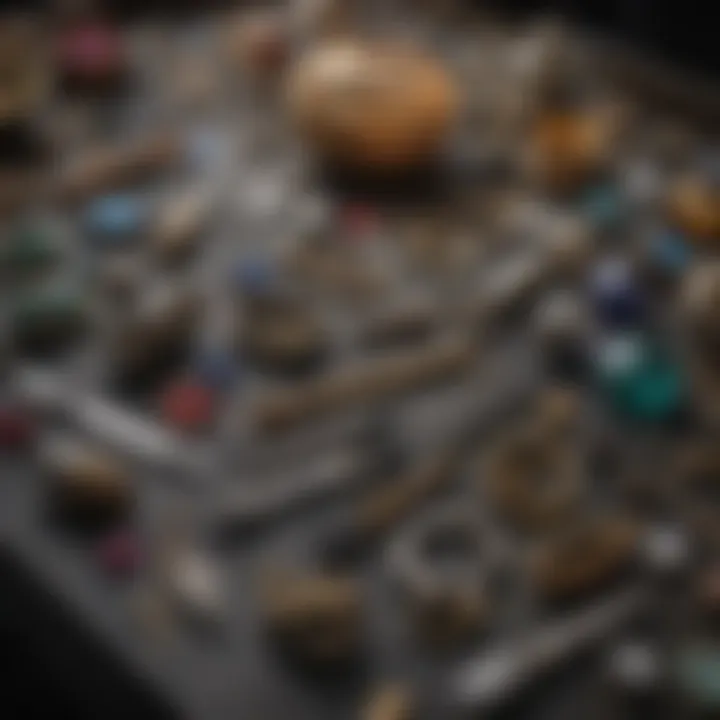
"Jewellery is a way of keeping memories alive and connecting us with our heritage."
In summary, examining the historical context of jewellery making not only helps to grasp the evolution of this art form but also emphasizes its multifaceted roles in society. This understanding is crucial for anyone engaging with jewellery, whether through making, wearing, or collecting.
Understanding Materials
Understanding materials is essential in jewellery making. The choice of materials not only affects the aesthetics of the finished piece but also impacts its durability, cost, and appeal to potential buyers. Different materials present unique properties and characteristics. This knowledge allows jewellers to choose wisely based on the desired style and market demand. Moreover, certain materials align with ethical considerations, thereby enhancing the jeweller's reputation in a conscientious market.
Types of Metals Used
Gold
Gold is one of the most sought-after metals in jewellery making. Its luster and malleability make it a favorite among designers and buyers alike. One key characteristic of gold is its resistance to tarnish, which preserves its beauty over time. Additionally, gold's value tends to appreciate, making it a solid investment for both makers and wearers. However, the environmental impact of mining gold is a disadvantage to consider. Ethical sourcing is crucial to address concerns related to exploitation and ecological damage.
Silver
Silver is another classic metal used in jewellery. Its bright appearance and affordability make it attractive for both novice and experienced jewellers. A notable characteristic of silver is its ability to be easily shaped and alloyed with other metals, enhancing its durability. However, silver tarnishes more readily than gold, which can detract from its surface if not properly maintained. Consequently, understanding care practices is essential for preserving silver jewellery.
Platinum
Platinum is known for its durability and rarity. It boasts a unique characteristic: it does not change in color or tarnish, ensuring longevity for jewellery pieces. Many consider this precious metal a symbol of luxury due to its weight and appearance. While platinum is more expensive than gold or silver, its enduring quality often justifies the investment. Nonetheless, the environmental implications of platinum mining can represent a drawback, making ethical sourcing an essential consideration for conscientious designers.
Alternative Metals
Alternative metals like titanium and tungsten have gained popularity in recent years. These materials are known for their strength and resistance to scratching, appealing to those who lead active lifestyles. A key attribute of alternative metals is their lightweight nature, which is comfortable for everyday wear. They can also be more affordable than traditional metals, making them accessible to a broader audience. However, their unique characteristics may limit some design possibilities that softer metals allow.
Gemstones and Their Properties
Natural vs. Synthetic
The distinction between natural and synthetic gemstones plays a significant role in jewellery making. Natural gemstones are formed over millions of years and carry inherent value due to their rarity. In contrast, synthetic gemstones are created in laboratories, often mimicking the properties of their natural counterparts. A critical aspect is authenticity; consumers increasingly prefer unique, genuine stones. However, synthetic gemstones provide consistency and affordability. Understanding the differences helps jewellers cater to diverse market preferences.
Ethical Sourcing
Ethical sourcing of gemstones has become a vital consideration for many in the jewellery industry. Ensuring that gemstones are obtained through responsible practices not only promotes environmental stewardship but also reflects positively on the jeweller's brand. A key characteristic of ethically sourced stones is the transparency surrounding their procurement methods. This emphasis can attract a conscious consumer base willing to pay a premium for items that align with their values. Failure to consider ethical sources may lead to negative repercussions and loss of trust.
Cut and Clarity
The cut and clarity of gemstones are critical factors that affect their overall appeal. Cut refers to the geometric shape of the stone, influencing how light interacts with it. Clarity indicates the presence of inclusions or imperfections, which can detract from its visual allure. A well-cut and high-clarity gemstone tends to be more valuable and desirable. Understanding these attributes allows jewellers to select stones that enhance their designs while meeting client expectations. A sound approach to cut and clarity optimizes the craftsmanship involved in the final product.
"The choice of materials in jewellery making significantly influences both the artistic expression and market value of the finished pieces."
Mastering the nuances of materials is crucial for jewellery makers, both for enhancing their craft and for ensuring sustainability in their practices.
Techniques and Skills
The realm of jewellery making is as much about creativity as it is about technique. Understanding various techniques equips both novices and experienced makers with the skills needed to bring their visions to life. Mastering these techniques presents clear benefits beyond just aesthetic appeal. Improved skills can lead to innovative designs, better craftsmanship, and overall satisfaction in the jewellery-making process. It's essential to grasp not only the basic principles but also to develop advanced skills as one progresses.
Basic Techniques for Beginners
Wire Wrapping
Wire wrapping is a foundational technique in jewellery making, known for its simplicity and versatility. This method involves using wire to create designs without soldering. Its contribution to the overall craft lies in the ease with which beginners can produce unique pieces. The key characteristic of wire wrapping is its accessibility; it requires minimal tools, making it a popular choice among novice jewellery makers. A unique feature of wire wrapping is the variety of styles it accommodates, from intricate designs to minimalist pieces. Its main advantages include allowing for quick creation and the potential for creative freedom. However, it can be challenging to achieve structural integrity, especially in larger designs.
Beading
Beading is another basic technique that introduces newcomers to jewellery making. This involves stringing beads onto wire or thread to create pieces like necklaces and bracelets. The process of beading allows for an exploration of color, patterns, and shapes. Its key characteristic is the broad range of materials available, from glass to gemstones. Beading is beneficial because it fosters creativity and can be done with minimal investment in tools. A unique aspect of beading is the opportunity for customization in each design. The disadvantage may include less durability compared to metalworking techniques, which could limit the longevity of some creations.
Simple Soldering
Simple soldering serves as a critical technique that bridges basic and advanced jewellery making. It enables the joining of metal pieces with the help of a soldering iron or torch. This technique contributes significantly to the ability to create more complex designs. The key characteristic of simple soldering lies in its practicality; it opens up numerous possibilities for constructing intricate pieces. This technique is a beneficial choice since it enhances the structural strength of designs, leading to more secure jewellery. A unique feature is the ability to work on metal combinations. However, it requires consistent practice and safety precautions, making it more complex for beginners to master.
Advanced Jewellery Making Techniques
Metalsmithing
Metalsmithing is an advanced technique encompassing various methods, including forging, casting, and engraving. It plays a significant role in developing distinctive, high-quality pieces. The core aspect of metalsmithing is its artistic expression combined with technical skill, making it a highly regarded choice among seasoned jewellers. The unique feature of this technique includes the ability to manipulate metal at various stages. Its advantages lie in the ability to create durable and intricate designs. However, the challenges lie in the learning curve and investment in tools and materials, making it less accessible for beginners.
Stone Setting
Stone setting is a critical advanced skill that transforms simple designs into stunning pieces adorned with gemstones. This technique involves securely placing stones into metal settings, fundamentally impacting the jewellery's beauty and value. Its key characteristic is precision, as the setting must complement the stone’s shape and size. Stone setting is a popular choice because it elevates jewellery design. The unique feature of this technique is the variety of settings available, such as prong, bezel, or pave settings. The disadvantages may include the necessity for expensive tools and the need for significant practice.
Enameling
Enameling is an advanced technique that adds color and texture to metal jewellery. It involves fusing powdered glass to a metal surface through heat. This technique contributes greatly to the artistic aspect of jewellery creation, allowing for personal expression. Its key characteristic includes the vivid colors available, making it appealing for creative projects. Enameling is a beneficial choice because it can create unique visual effects that are hard to achieve through other means. A unique aspect is the diverse techniques within enameling itself. However, the complexity and skill required for consistent results can be a significant barrier for beginners.
Designing Jewellery
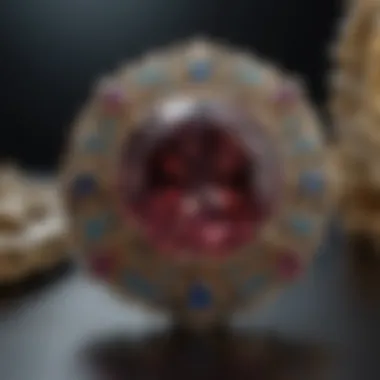
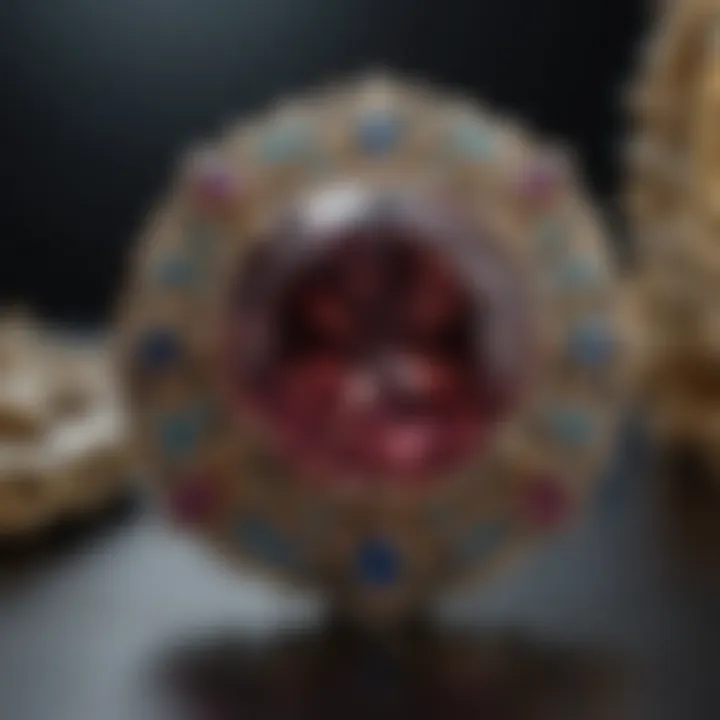
Designing jewellery is a critical component in the process of jewellery making. It encompasses not just the creative aspects, but also technical capabilities that bridge imagination with execution. The design phase influences the entire outcome of the piece, from functionality to aesthetic appeal. Moreover, designing jewellery requires a deep understanding of materials, techniques, and trends in the industry. Such knowledge allows for the creation of pieces that are not only beautiful but also wearable and meaningful.
The Design Process
The design process in jewellery making involves several key stages. Each stage contributes uniquely to the final piece, ensuring it meets the vision of the designer while being practical for production.
Conceptualization
Conceptualization is the first step in the design process. It involves generating ideas and exploring themes. This phase fosters creativity and innovation, allowing the designer to brainstorm various possibilities without constraints. A key characteristic of this stage is its emphasis on imagination. It is beneficial because it lays a strong foundation for subsequent designs and decisions. The unique feature of conceptualization lies in its flexibility; designers can explore various influences from art, nature, or even personal experiences. However, one disadvantage is that without proper focus, many ideas may lead to inconsistency in the final design.
Sketching
Sketching follows conceptualization as a crucial step in the design process. This involves transforming ideas into visual representations. Sketching is immensely beneficial because it captures the essence of the concept while allowing for modifications and refinements. The primary characteristic of sketching is its simplicity; it does not require high-level artistic skills to convey ideas. Its unique feature is that it serves as a reference for further stages of design. However, one downside can be the potential for misinterpretation about the final aesthetics or details, if the sketches are not clear enough.
Prototyping
Prototyping is the stage where the designs transition from paper to tangible forms. It allows designers to create three-dimensional representations of their ideas. The key characteristic of prototyping is its emphasis on functionality; it helps to test the viability of a design before production. This stage is especially beneficial because it allows for adjustments based on practical considerations. The unique feature of prototyping is that it offers a hands-on experience that can reveal design flaws or improvements that might not be visible in sketches. However, a disadvantage is that it can be time-consuming and may require additional resources.
Balancing Aesthetics and Functionality
When designing jewellery, it is essential to balance aesthetics and functionality. A piece may look attractive, but if it lacks practicality, its value diminishes. The best designs often incorporate both attributes, appealing to the senses while ensuring wearability. For example, a ring may be intricately designed, but if it is uncomfortable to wear, it fails in its purpose.
Tools and Equipment
Understanding the tools and equipment required for jewellery making is central to mastering the craft. The right tools can significantly influence the quality and precision of your creations. Each piece of jewellery demands specific tools that cater to different techniques. Novices and experienced jewellers alike benefit from knowing which tools to use and how to utilize them effectively. Furthermore, equipment quality can affect not only the crafting process but also safety in the workshop.
Essential Tools for Beginners
For those just starting out in jewellery making, having the essential tools is vital to create basic designs. These tools do not need to be overly sophisticated but should be reliable and functional. Here is a list of tools that all beginners should consider:
- Pliers: Round-nose, flat-nose, and chain-nose pliers are crucial. They help in bending and shaping wire as well as opening and closing jump rings.
- Wire Cutters: A strong pair of wire cutters is needed to trim metal and beading wires cleanly.
- Beading Needles: Using the right needle is important for stringing beads effectively.
- Cutting Mat: A protective cutting mat shields your workspace while making clean cuts.
- Soldering Iron: A basic soldering iron can facilitate joining metal pieces together.
- Ruler and Measuring Tools: Accurate measurement is key in creating jewellery pieces that fit well.
- Jewellery File: A file helps smoothen rough edges on metal pieces.
These tools form the foundational setup for anyone eager to learn the intricacies of the craft. They are accessible and affordable, making them ideal for beginners.
Advanced Tools for Professionals
As jewellery making advances from a hobby to a profession, a jeweller's toolkit must also grow in sophistication. Professional jewellers often require a more expansive range of tools to handle complex projects. Below are some advanced tools that are common in the professional jewellery workshop:
- Rolling Mill: This device is used to flatten and shape metal, allowing for the creation of custom wire and sheet metal.
- Torch for Soldering: A high-quality torch is essential for soldering, enabling better control of heat when working with metals.
- Jeweller's Bench: A sturdy workbench with a variety of built-in tools can greatly enhance workflow and comfort during lengthy crafting sessions.
- Dremel Tool: This versatile tool can be adapted to various functions including polishing, carving, and sanding different materials.
- Ultrasonic Cleaner: An ultrasonic cleaner ensures that finished pieces are thoroughly cleaned, removing any residues and enhancing their shine.
- Gemstone Setting Tools: These specialized tools help in the precise setting of stones and ensuring durability in designs.
Having access to these advanced tools not only enhances the quality of craftsmanship but also improves the efficiency of work. It is important for professionals to continuously evaluate their toolkit and make upgrades as needed.
"The tools you choose can shape not only the outcomes of your work but can also define your style and methodology."
For more information on specific tools and how to use them, visit Wikipedia or Britannica. Check out various discussions on jewellery making tools on Reddit or join jewellery communities on Facebook.
Safety Considerations
Jewellery making can be a rewarding but sometimes dangerous craft. Safety considerations are crucial for both beginners and experienced artisans. Ensuring safety while creating jewellery not only protects the individual but also improves the overall crafting experience. Awareness of risks is key to preventing accidents related to tools, materials, and work environment. Incorporating safety measures ensures that the passion for jewellery making does not come at a cost to health or wellbeing.
Safety Gear and Equipment
Using appropriate safety gear is vital in jewellery making. Different tasks require various types of personal protective equipment. Here are some essential items:
- Safety Goggles: Protect your eyes from debris when cutting, grinding or soldering.
- Dust Masks: Important for preventing inhalation of harmful dust, especially when sanding or using chemicals.
- Ear Protection: Useful when using power tools that produce loud noise, to prevent hearing damage.
- Protective Gloves: Leather or rubber gloves can shield your hands from sharp objects and chemicals, which can cause burns or cuts.
- Aprons: A sturdy apron can protect your clothing and body from hot metals or sharp tools.
Investing in quality safety gear is a small price to pay for the protection it provides. It fosters a focused environment to create without undue concern for injury.
Proper Work Environment
The work environment for jewellery making should be conducive to both safety and productivity. Here are some factors to consider:
- Well-Ventilated Space: Ensure adequate airflow to avoid inhaling hazardous fumes from materials or tools.
- Proper Lighting: Good lighting is necessary to see fine details and to work safely with small components.
- Organized Workspace: Keeping tools and materials organized minimizes the risk of accidents. A clutter-free area allows for easier movement and reduces potential hazards.
- Fire Safety: Having a fire extinguisher nearby is essential, especially if using soldering tools or flammable materials.
- Ergonomic Setup: Use a comfortable chair and desk height to prevent strain during long work sessions.
Creating a safe work environment reflects a commitment to quality craftsmanship. Taking these considerations seriously can enhance not only safety but also creativity and efficiency in jewellery making.
"Safety in the workshop fosters a more enjoyable and innovative crafting experience."
Overall, prioritizing safety gear and a proper work setup in jewellery making is both a wise and necessary step. As artisans focus on their creations, safety measures must remain a constant thought.
Sourcing Ethical Materials
Sourcing ethical materials is an essential topic in jewellery making. It not only addresses the ecological footprint of the materials used but also supports fair labor practices and the well-being of communities involved in the production process. In today's market, consumers are increasingly educated and concerned about the origins of the products they purchase. Therefore, understanding and implementing ethical sourcing practices can significantly impact a jeweller's reputation and business sustainability.
When jewellers choose to source their materials ethically, they often find benefits beyond the moral obligation. Ethical sourcing enhances brand loyalty. Consumers are more likely to support businesses that demonstrate commitment to social responsibility. This commitment can open new marketing avenues. It can also lead to partnerships with other like-minded organizations, thereby expanding potential customer bases.


Consideration of ethical sourcing involves several elements. These include understanding the provenance of metals and gemstones. For example, gold sourced from mines with fair labor practices prevents the exploitation of workers. Similarly, gemstones that are ethically sourced often have certifications that guarantee they are conflict-free, ensuring that their sale does not fund violence or human rights abuses.
"Ethical sourcing is not just a trend; it's a necessity for the future of jewellery making."
By being mindful of these factors, jewellers can not only improve their craft but also engage in practices that benefit both people and the planet.
The Business of Jewellery Making
The realm of jewellery making extends beyond the artistry and craftsmanship. Understanding the business side is crucial for any serious jeweller, whether they are pursuing this craft as a hobby or career. The business of jewellery making encompasses various aspects like marketing, sales strategies, and understanding the market demands. As a jeweller, one must not only create exceptional pieces but also develop a strategy to reach buyers effectively and sustainably.
In this section, we explore key elements that illustrate the importance of treating jewellery making as a business:
- Understanding Brand Identity: Establishing a unique brand identity is vital. This includes defining what makes your jewellery distinct and appealing.
- Pricing Strategy: One must consider production costs, market positioning, and perceived value while setting prices. This can impact sales significantly.
- Customer Engagement: Building a loyal customer base through engagement ensures repeat business and referrals.
- Market Trends: Staying informed about current trends and customer preferences aids in designing pieces that resonate with potential buyers.
Overall, a sound business strategy enhances not only sales but also the reputation of the jeweller in a competitive marketplace.
Marketing Your Creations
Effective marketing is indispensable in showcasing and selling jewellery. The first step involves understanding target audiences, which may include gemstone enthusiasts, collectors, or gift buyers. This knowledge can tailor marketing efforts to appeal to their specific interests.
Considerations for marketing include:
- Online Presence: A strong online presence through social media and a dedicated website can showcase your creations to a wider audience. Platforms such as Instagram and Pinterest are visually driven, making them ideal for jewellery.
- Networking: Attending industry events, trade shows, or local craft fairs provides opportunities to display work and connect with potential customers and other artisans.
- Storytelling: Developing a brand story that embodies the craftsmanship and inspiration behind your pieces can create an emotional connection with buyers.
Recommendations for marketing strategies:
- Utilize SEO to drive organic traffic to your online store.
- Consider collaborations with influencers who target your audience.
- Offer limited-time promotions or exclusive pieces to create a sense of urgency.
Navigating Online Sales Platforms
The digital marketplace has transformed how jewellery is sold. Online platforms such as Etsy, eBay, and Shopify provide jewellers the ability to reach a global audience, but understanding how to navigate these platforms is essential.
Key aspects include:
- Choosing the Right Platform: Not all online platforms suit every jeweller. Consider factors like fees, audience, and ease of use.
- Product Listings: High-quality images and detailed descriptions are crucial. A poor representation can lead to lost sales.
- Customer Service: Being responsive and providing excellent service enhances reputation and can lead to positive reviews, which are critical in online sales.
Excellent customer service can turn a one-time buyer into a lifelong fan.
- Shipping Considerations: Clearly outline your shipping policies, including costs and delivery times. Consider international shipping options if applicable.
Jewellery Making Communities
Jewellery making is not just an individual practice; it thrives within communities that share a passion for this intricate craft. Participating in such communities offers numerous benefits that enrich both the art of jewellery making and the jewellers themselves. From exchanging ideas to gaining feedback on designs, jewellery making communities create spaces for collaboration and innovation, allowing members to grow in their skills and understanding of the craft.
Networking Opportunities
Networking plays a vital role in the development of a jeweller's career. By joining jewellery making communities, whether online or offline, artists can connect with fellow makers, shop owners, and even suppliers. These networks can lead to collaborations, mentorships, and job opportunities. For example, interacting with an established jeweller can provide insights into techniques and business practices that one might not learn through formal education.
Moreover, exposure to different perspectives can inspire new designs and methods. Online platforms such as Facebook groups and forums on Reddit provide a virtual space for discussions, allowing jewellers to ask questions and share successes. Local groups often organize meetups, which can yield personal connections and support that are crucial in a competitive industry.
Workshops and Events to Consider
Participation in workshops and events is another essential aspect of being part of jewellery making communities. Workshops often cover a range of topics from basic skills to advanced techniques, presenting firsthand opportunities to learn from experts. These hands-on experiences foster a deeper understanding of materials and tools while encouraging creativity.
Events such as jewellery fairs, trade shows, and exhibitions also allow jewellers to showcase their work, gain visibility, and interact with potential customers. Attending these events can lead to invaluable feedback on one's creations, thus enhancing the overall craft.
Investing time in workshops and events not only sharpens skills but also builds lasting relationships that extend beyond the craft itself.
Finale
The conclusion of this article serves as a vital component in summarizing the intricate journey through jewellery making. It provides the reader with a sense of closure while also offering insights into what they have gained from the discussion. Reflecting on personal experiences in this craft can deepen understanding. Every jeweller, whether beginner or advanced, may recognize their growth and challenges faced during the process. This retrospective view is important because it highlights the evolution of skills and creativity.
Moreover, an examination of future trends in jewellery making can inspire continuous learning and adaptation. The industry is ever-changing, influenced by technology and consumer preferences. Keeping abreast of these trends allows artisans to innovate, ensuring their work stays relevant in an increasingly competitive market.
This discussion emphasizes the importance of considering ethical sourcing and sustainable practices. In recent years, more consumers prioritize transparency and responsibility in their purchases. By focusing on these aspects in future work, jewellers can not only cater to this demand but also enhance their own artistic integrity.
In summary, the conclusion serves as a reflective moment and a forward-looking perspective. Acknowledging personal growth and the broader trends encourages jewellers to remain engaged and passionate about their craft. Embracing change and responsibility can lead to a flourishing practice.
Reflecting on Your Journey
Reflecting on your journey in jewellery making is crucial as it allows you to assess not only your technical skills but also your creative evolution. Each piece created tells a story of challenges overcome and lessons learned. For instance, novice jewellers often face initial struggles with basic techniques, but with practice, these challenges become easier to handle.
Consider maintaining a journal to document progress. This can include sketches, ideas for new designs, and notes on techniques learned. Such a journal serves as a tangible record of your growth, which can be motivating on tough days. Additionally, share your journey in online communities. This engagement can provide encouragement and constructive feedback. When you share your work or challenges with others, it creates a supportive network that can enhance your experience.
Analyzing previous projects can illuminate those areas where improvement is needed. Perhaps certain techniques need more practice, or maybe there is a specific design style that has not yet been explored. By reflecting on these elements, you build a roadmap for your future in jewellery making.
Future Trends in Jewellery Making
As the jewellery industry continues to evolve, several trends are shaping its future. One notable trend is the increasing utilization of 3D printing technology. It allows designers to create intricate pieces that may be difficult to produce by traditional means. This innovation can alleviate some technical limitations, making it easier to experiment with designs.
Another significant consideration is the ethical implications of sourcing materials. Consumers are becoming more aware of where their gemstones and metals come from, pushing jewellers to adopt more sustainable practices. This could mean implementing traceable supply chains or opting for recycled materials. The growing interest in unapologetically ethical products may define the next generation of jewellery makers, attracting a clientele that values responsibility alongside artistry.
Furthermore, the rise of digital marketing and e-commerce platforms continues to change how jewellery is sold. Artisans must learn to navigate these platforms effectively to reach broader audiences. Building an online presence through social media is also becoming essential. Sharing not just the finished product but the process behind it engages potential customers on a deeper level.



